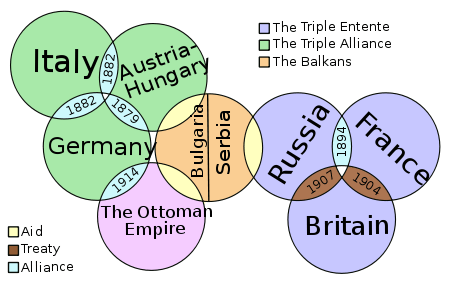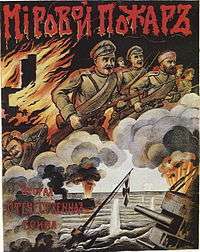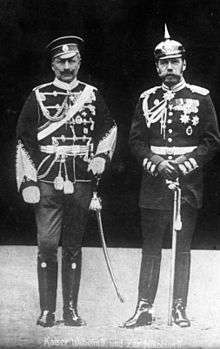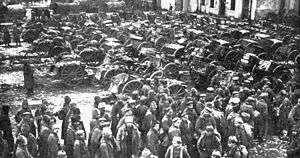Russian entry into World War I
Russia entered into World War I on August 1, 1914, when Germany declared war on it. In accordance with its war plan, Germany ignored Russia and moved first against France--declaring war on August 3 and sending its main armies through Belgium to attack Paris from the north. The invasion of Belgium caused Britain to declare war on Germany on August 4. The main parties were now at war. Soon Turkey joined on Germany's side, and later Italy on the Allied side.
The Archduke Franz Ferdinand of Austro-Hungary was assassinated by Bosnian Serbs on 28 June 1914 to protest Austrian takeover of a largely Slavic province. Vienna was unable to find that Serbia sponsored the assassination but a month later issued an ultimatum to Serbia, which it knew would be rejected and thus lead to war. Austria felt that Serbia had to be destroyed or else it would alienate the very large Slavic minority element in Austria-Hungary and thus destabilize Austria. Russia did not have a treaty obligation to Serbia but stood in opposition to Austria for control of the Balkans. In long-term perspective, Russia was militarily gaining on Germany and Austro-Hungary, and thus had an incentive to wait. Most Russian leaders wanted to avoid a war. However, in the present crisis they had the support of France, and they feared that the failure to support Serbia would lead to a loss of Russian credibility and a major political defeat to Russia's goals for a leadership role in the Balkans.[1] Tsar Nicholas II mobilised Russian forces on 30 July 1914 to threaten Austria if it invaded Serbia. Christopher Clark states: "The Russian general mobilisation [of 30 July] was one of the most momentous decisions of the July crisis. This was the first of the general mobilisations. It came at the moment when the German government had not yet even declared the State of Impending War".[2] Germany now felt threatened by Russia and responded with her own mobilisation and declaration of war on 1 August 1914. At the opening of hostilities, the Russians took the offensive against both Germany and Austria-Hungary.[3]

Background
Between 1873-1887, Russia was allied with Germany and Austria-Hungary in the League of the Three Emperors, then with Germany in the 1887-1890 Reinsurance Treaty; both collapsed due to the competing interests of Austria and Russia in the Balkans. While France took advantage of this to agree the 1894 Franco-Russian Alliance, Britain viewed Russia with deep suspicion; in 1800, over 3,000 kilometres separated the Russian Empire and British India, by 1902, it was 30 km in some areas.[4] This threatened to bring the two into direct conflict, as did the long-held Russian objective of gaining control of the Bosporus Straits and with it access to the British-dominated Mediterranean Sea.[5]

Defeat in the 1905 Russo-Japanese War and Britain's isolation during the 1899-1902 Second Boer War led both parties to seek allies. The Anglo-Russian Convention of 1907 settled disputes in Asia and allowed the establishment of the Triple Entente with France, which at this stage was largely informal. In 1908, Austria annexed the former Ottoman province of Bosnia and Herzegovina; Russia responded by creating the Balkan League in order to prevent further Austrian expansion.[6] In the 1912-1913 First Balkan War, Serbia, Bulgaria and Greece captured most of the remaining Ottoman possessions in Europe; disputes over the division of these resulted in the Second Balkan War, in which Bulgaria was comprehensively defeated by its former allies.
Russia's industrial base and railway network had significantly improved since 1905, although from a relatively low base; in 1913, Tsar Nicholas approved an increase in the Russian Army of over 500,000 men. Although there was no formal alliance between Russia and Serbia, their close bilateral links provided Russia with a route into the crumbling Ottoman Empire, where Germany also had significant interests. Combined with the increase in Russian military strength, both Austria and Germany felt threatened by Serbian expansion; when Austria invaded Serbia on 28 July 1914, Russian Foreign Minister Sergey Sazonov viewed it as an Austro-German conspiracy to end Russian influence in the Balkans.[7]
On 30 July, Russia declared general mobilisation in support of Serbia; on 1 August, Germany declared war on Russia, followed by Austria-Hungary on 6th. Russia and the Entente declared war on the Ottoman Empire in November 1914, after Ottoman warships bombarded the Black Sea port of Odessa in late October.[8] Unlike its Allies, Russia's Empire was one contiguous landmass but it also considered itself the defender of its fellow Slavs in countries like Serbia.
Major players
Historians agree on the poor quality of Russia's top leadership.[9] Tsar Nicholas II made all the final decisions, but he repeatedly was given conflicting advice and typically made the wrong choice. He set up a deeply flawed organizational structure that was inadequate for the high pressures and instant demands of wartime. British Historian David Stevenson, for example, points to the "disastrous consequences of deficient civil-military liaison" where the civilians and generals were not in contact with each other. The government was entirely unaware of its fatal weaknesses and remained out of touch with public opinion; the foreign minister had to warn the tsar that "unless he yielded to the popular demand and unsheathed the sword on Serbia's behalf, he would run the risk of revolution and the loss of his throne." The tsar yielded and lost his throne anyway. Stevenson concludes:
- Russian decision-making in July [1914] was more truly a tragedy of miscalculation...a policy of deterrence that failed to deter. Yet [like Germany] it too rested on assumptions that war was possible without domestic breakdown, and that it could be waged with a reasonable prospect of success. Russia was more vulnerable to social upheaval than any other Power. Its socialists were more estranged from the existing order than those elsewhere in Europe, and a strike wave among the industrial workforce reached a crescendo with the general stoppage in St. Petersburg in July 1914.[10]
Foreign Minister Sergey Sazonov was not a powerful player. Historian Thomas Otte finds that, "Sazonov felt too insecure to advance his positions against stronger men....He tended to yield rather than to press home his own views.... At the critical stages of the July crisis Sazonov was inconsistent and showed an uncertain grasp of international realities.[11] The tsar fired Sazonov in July 1916 and gave his ministry as an extra portfolio to Prime Minister Stürmer. The French ambassador was aghast, depicting Stürmer as, "worse than a mediocrity – a third rate intellect, mean spirit, low character, doubtful honesty, no experience, and no idea of state business."[12]
French ambassador Maurice Paléologue was also influential, repeatedly promising France would go to war along with Russia, which was indeed the position of President Raymond Poincaré.
- Nicholas II — Russian Emperor, until 15 March 1917)
- Grand Duke Nicholas Nikolaevich – Commander-in-chief (1 August 1914 – 5 September 1916) and viceroy in the Caucasus
- Ivan Goremykin – Chairmen of Council of Ministers of the Russian Empire (1 August 1914 – 2 February 1916)
- General of the Artillery Nikolay Ivanov – Commander of the Russian army on the Southwestern Front, (1 August 1914 – March 1916) responsible for much of the action in Galicia
Serious planning for a future war was practically impossible given the complex rivalries and priorities given to royalty. The main criteria for high command was linkage to the royalty, rather than expertise. The General Staff had expertise, but was often outweighed by the elite Imperial Guards, a favourite bastion of aristocracy which prized parades over planning large-scale military maneuvers. The grand dukes inevitably gained high commands. At one critical point when Grand Duke Nicholas failed badly, the tsar himself took over direct command and control of the entire Army, despite his incompetence. Meanwhile the tsar allowed the conniving monk Grigori Rasputin to exert enormous influence through his wife, including high-level appointments. The aristocrats finally assassinated him a few weeks before the tsar himself was overthrown. The infantry, artillery, cavalry, and logistics services suffered poor communications with one another. The Army was made up of peasants, who were ready enough to defend their own villages, but showed little national pride. Numerous minorities often were teased and tortured in the barracks.[13]
French alliance
Russia depended heavily on the French alliance--a two front war against Germany was winnable, but not if Russia was alone. French ambassador Maurice Paléologue hated Germany and saw that when war broke out France and Russia had to be close allies against Germany. His approach was in agreement with President minister Raymond Poincaré who trusted him. He promised unconditional French support to Russia in the unfolding crisis with Germany and Austria. Historians debate whether he exceeded his instructions but they agree he failed to inform Paris of exactly what was happening, and did not warn that Russian mobilization might launch a world war.[14][15][16]
War begins
When on 28 June 1914 Archduke Franz Ferdinand of Austria was assassinated in Sarajevo Tsar Nicholas vacillated as to Russia's course of action. A relatively new factor influencing Russian policy was the growth of Pan-Slavism spirit that identified Russia's duty to all Slavic speaking peoples, especially those who are Orthodox in religion. The growth of this impulse shifted attention away from the Ottoman Empire, and toward the threat posed to the Slavic people by the Austro-Hungarian Empire. Serbia identified itself as the champion of the Pan-Slavic ideal; Austria planned to destroy Serbia for that reason. [17] Nicholas wanted to defend Serbia, but not to fight a war with Germany. In a series of letters exchanged with Kaiser Wilhelm of Germany (the so-called "Willy and Nicky correspondence") the two cousins proclaimed their desire for peace, and each attempted to get the other to back down. Nicholas desired that Russia's mobilization be only against the Austrian border, in the hopes of avoiding war with Germany. The Kaiser however had pledged to support Austria.

On 25 July 1914, Tsar Nicholas decided to intervene in the Austro-Serbian conflict, a step toward general war. He put the Russian army on "alert" on 25 July. Although this was not general mobilization, it threatened the German and Austrian borders and looked like military preparation for war. However, his army had few workable plans and no contingency plans for a partial mobilization, and on 30 July 1914 Nicholas took the fateful step of confirming the order for general mobilization, despite being strongly counselled against it.
On 28 July, Austria-Hungary formally declared war against Serbia. [18][19] Count Witte told the French Ambassador, Maurice Paléologue that from Russia's point of view the war was madness, Slav solidarity was simply nonsense and Russia could hope for nothing from the war.[20]

On 30 July, Russia ordered general mobilisation, but still maintained that it would not attack if peace talks were to begin. Germany, reacting to the discovery of Russian partial mobilisation ordered on 25 July, announced its own pre-mobilisation posture, the Imminent Danger of War. Germany requested that Russia must demobilise within the next twelve hours. In Saint Petersburg, at 7pm, with the German ultimatum to Russia expired, the German ambassador to Russia met with the Russian Foreign Minister Sergey Sazonov, asked three times if Russia would reconsider, and then with shaking hands, delivered the note accepting Russia's war challenge and declaring war on 1 August. On 6 August, Franz Joseph I of Austria signed the Austro Hungarian declaration of war on Russia.
The outbreak of war on 1 August 1914 found Russia grossly unprepared. Russia and her allies placed their faith in her army, the famous 'Russian steamroller'. Its pre-war regular strength was 1,400,000; mobilisation added 3,100,000 reserves and millions more stood ready behind them. In every other respect, however, Russia was unprepared for war. Germany had ten times as much railway track per square mile, and whereas Russian soldiers travelled an average of 1,290 kilometres (800 mi) to reach the front, German soldiers travelled less than a quarter of that distance. Russian heavy industry was still too small to equip the massive armies the Tsar could raise, and her reserves of munitions were pitifully small; while the German army in 1914 was better equipped than any other, man-for-man, the Russians were severely short on artillery pieces, shells, motorised transports, and even boots. [21]
Before the war Russian planners had completely neglected the critical issue of logistics-- how would West European allies ship supplies and munitions to Russia? With the Baltic Sea barred by German U-boats and the Dardanelles by the guns of Germany's ally, the Ottoman Empire, Russia initially could receive help only via Archangel, which was frozen solid in winter, or via Vladivostok, which was over 6,400 kilometres (4,000 mi) from the front line. By 1915, a new rail line was begun gave access to the ice-free port of Murmansk by 1917.[22]
The Russian High Command was greatly weakened by the mutual contempt between Vladimir Sukhomlinov, the Minister of War, and the experienced warrior Grand Duke Nicholas who commanded the armies in the field. In spite of all of this, an immediate attack was ordered against the German province of East Prussia. The Germans mobilised there with great efficiency and completely defeated the two Russian armies which had invaded. The Battle of Tannenberg, where an entire Russian army was annihilated, cast an ominous shadow over the empire's future. The loyal officers lost were the very ones needed to protect the dynasty. The Russian armies had some success against both the Austro-Hungarian and Ottoman armies, but they were steadily pushed back by the German Army. In September 1914, in order to relieve pressure on France, the Russians were forced to halt a successful offensive against Austria-Hungary in Galicia in order to attack German-held Silesia.[23]
Gradually a war of attrition set in on the vast Eastern Front, where the Russians were facing the combined forces of the German and Austro-Hungarian Empires, and they suffered staggering losses. General Denikin, retreating from Galicia wrote:
- The German heavy artillery swept away whole lines of trenches, and their defenders with them. We hardly replied. There was nothing with which we could reply. Our regiments, although completely exhausted, were beating off one attack after another by bayonet ... Blood flowed unendingly, the ranks became thinner and thinner and thinner. The number of graves multiplied.[24]
See also
Notes
- ↑ Jack S. Levy, and William Mulligan, "Shifting power, preventive logic, and the response of the target: Germany, Russia, and the First World War." Journal of Strategic Studies 40.5 (2017): 731-769.
- ↑ Christopher Clark, The Sleepwalkers: How Europe Went to War in 1914 (2013 p 509.
- ↑ W. Bruce Lincoln, Passage Through Armageddon: The Russians in War and Revolution, 1914–1918 (1986)
- ↑ Hopkirk, Peter (1990). The Great Game; On Secret Service in High Asia (1991 ed.). OUP. pp. 4–5. ISBN 0719564476.
- ↑ Dennis, Alfred L.P. (December 1922). "The Freedom of the Straits". The North American Review. 216 (805): 728–729. Retrieved 16 August 2018.
- ↑ Stowell, Ellery Cory (1915). The Diplomacy of the War of 1914: The Beginnings of the War (2010 ed.). Kessinger Publishing. p. 94. ISBN 1165819562.
- ↑ Jelavich, Barbara (2008). Russia's Balkan Entanglements. Cambridge University Press. p. 262. ISBN 0521522501.
- ↑ Afflerbach, Holger (ed), Stevenson, david (ed), Aksakal, Mustafa (2012). War as a Saviour? Hopes for War & Peace in Ottoman Politics before 1914 in An Improbable War? the Outbreak of World War I and European Political Culture Before 1914. Berghahn Books. p. 293. ISBN 0857453106.
- ↑ D.C.B. Lieven, Russia and the Origins of the First World War (1983) pp 51-140
- ↑ David Stevenson, The First World War and International Politics (1988) pp. 31–32.
- ↑ T. G. Otte (2014). July Crisis: The World's Descent into War, Summer 1914. pp. 123–24.
- ↑ Walter G. Moss, A History of Russia: volume I: to 1917 (1997) pp. 499–504, quote on p. 503
- ↑ Peter Gatrell, "Tsarist Russia at War: The View from Above, 1914–February 1917." Journal of Modern History 87.3 (2015): 668-700 at pp 674-77.
- ↑ Richard F. Hamilton and Holger H. Herwig. Decisions for war, 1914-1917 (2004) pp 121-22.
- ↑ Christopher Clark, The sleepwalkers: How Europe went to war in 1914 (2012) pp 435-50, 480-84.
- ↑ Sidney B. Fay, The Origins of the World War (1934) 2:443-46.
- ↑ Katrin Boeckh, "The Rebirth of Pan-Slavism in the Russian Empire, 1912–13." in Katrin Boeckh and Sabine Rutar, eds. The Balkan Wars from Contemporary Perception to Historic Memory (2016) pp. 105-137.
- ↑ Hew Strachan, The First World War, Vol I: To Arms (2001), p. 85
- ↑ Richard F. Hamilton, and Holger H. Herwig, eds. ) Origins of World War One (2003) p. 514
- ↑ Robert K. Massie (1967). Nicholas and Alexandra: The Fall of the Romanov Dynasty. p. 299.
- ↑ Hew Strachan, The First World War (2001) pp 297-316.
- ↑ Richard Pipes (2011). The Russian Revolution. p. 207.
- ↑ Hew Strachan, The First World War (2001) pp 316-35.
- ↑ Tames, p. 46
Further reading
- Alexinsky, Gregor. Russia and the great war (1915) pp 1-122. online free
- Bobroff, Ronald P. Roads to Glory: Late Imperial Russia and the Turkish Straits (I.B. Tauris 2006).
- Bobroff, Ronald P. "War Accepted but Unsought: Russia’s Growing Militancy and the July Crisis, 1914", in Jack S. Levy and John A. Vasquez, eds., The Outbreak of the First World War (Cambridge UP 2014), 227–51.
- Brandenburg, Erich. (1927) From Bismarck to the World War: A History of German Foreign Policy 1870–1914 (1927) online.
- Bury, J.P.T. "Diplomatic History 1900–1912, in C. L. Mowat, ed. The New Cambridge Modern History: Vol. XII: The Shifting Balance of World Forces 1898-1945 (2nd ed. 1968) online pp 112-139.
- Clark, Christopher. The Sleepwalkers: How Europe Went to War in 1914 (2013) excerpt
- Sleepwalkers lecture by Clark. online
- Fay, Sidney B. The Origins of the World War (2 vols in one. 2nd ed. 1930). online, passim
- Fromkin, David. Europe's Last Summer: Who Started the Great War in 1914? (2004).
- Fuller, William C. Strategy and Power in Russia 1600–1914 (1998) excerpts; military strategy
- Gatrell, Peter. "Tsarist Russia at War: The View from Above, 1914–February 1917." Journal of Modern History 87.3 (2015): 668-700. online
- Geyer, Dietrich. Russian Imperialism: The Interaction of Domestic and Foreign Policy, 1860-1914 (1987).
- Hewitson, Mark. Germany and the Causes of the First World War (2004) online
- Herweg, Holger H., and Neil Heyman. Biographical Dictionary of World War I (1982).
- Jelavich, Barbara. St. Petersburg and Moscow: tsarist and Soviet foreign policy, 1814-1974 (1974).
- Jelavich, Barbara. Russia's Balkan Entanglements, 1806-1914 (2004).
- Joll, James; Martel, Gordon (2013). The Origins of the First World War (3rd ed.). Taylor & Francis. online free to borrow
- Kennan, George Frost. The fateful alliance: France, Russia, and the coming of the First World War (1984) online free to borrow; covers 1890 to 1894.
- Kennedy, Paul M., ed. (1979). The War Plans of the Great Powers: 1880-1914.
- Levy, Jack S., and William Mulligan. "Shifting power, preventive logic, and the response of the target: Germany, Russia, and the First World War." Journal of Strategic Studies 40.5 (2017): 731-769. online
- Lieven, Dominic. Empire: The Russian empire and its rivals (Yale UP, 2002), comparisons with British, Habsburg & Ottoman empires.excerpt
- Lieven, D.C.B. Russia and the Origins of the First World War (1983). online free to borrow
- Lincoln, W. Bruce. Passage Through Armageddon: The Russians in War and Revolution, 1914-1918 (1986) pp 23-59.
- Lincoln, W. Bruce. In war's dark shadow : the Russians before the Great War (1983) online free to borrow pp 399-444.
- McMeekin, Sean. The Russian Origins of the First World War (2011).
- McMeekin, Sean. July 1914: Countdown to War (2014) scholarly account, day-by-day excerpt
- MacMillan, Margaret (2013). The War That Ended Peace: The Road to 1914. Random House. ; major scholarly overview
- Menning, Bruce. "War planning and initial operations in the Russian context," in Richard F. Hamilton, Holger Herwig. eds., War Planning, 1914 (2010), 120–26.
- Menning, Bruce. "Russian Military Intelligence, July 1914: What St. Petersburg Perceived and Why it Mattered," Historian 77#2 (2015), 213–68. doi:10.1111/hisn.12065
- Neumann, Iver B. "Russia as a great power, 1815–2007." Journal of International Relations and Development 11#2 (2008): 128–151. online
- Olson, Gust, and Aleksei I. Miller. "Between Local and Inter-Imperial: Russian Imperial History in Search of Scope and Paradigm." Kritika: Explorations in Russian and Eurasian History (2004) 5#1 pp: 7–26.
- Otte, T. G. July Crisis: The World's Descent into War, Summer 1914 (Cambridge UP, 2014). online review
- Renzi, William A. "Who Composed" Sazonov's Thirteen Points"? A Re-Examination of Russia's War Aims of 1914." American Historical Review 88.2 (1983): 347-357. online; argues that French ambassador Maurice Paléologue was responsible
- Rich, Norman. Great Power Diplomacy: 1814-1914 (1991), comprehensive survey
- Rich, David Allen. "Russia," in Richard F. Hamilton and Holger H. Herwig, eds. Decisions for War, 1914-1917 (2004), pp 188–226.
- Ritter, Gerhard. The Sword and the Sceptre, Vol. 2-The European Powers and the Wilhelmenian Empire 1890-1914 (1970) Covers military policy in Germany and also France, Britain, Russia (pp 77-89) and Austria.
- Schmitt, Bernadotte E. The coming of the war, 1914 (2 vol 1930) comprehensive history online vol 1; online vol 2, esp vol 2 ch 20 pp 334-382
- Scott, Jonathan French. Five Weeks: The Surge of Public Opinion on the Eve of the Great War (1927) online. especially ch 8: "The psychotic explosion in Russian" pp 154-79
- Seton-Watson, Hugh. The Russian Empire 1801–1917 (1967) pp 677–697.
- Soroka, Marina. Britain, Russia and the Road to the First World War: The Fateful Embassy of Count Aleksandr Benckendorff (1903–16) (2016).
- Spring, D.W. "Russia and the Coming of War" in R. J. W. Evans ed., Coming of the First World War (2001) pp 57-86. online
- Stowell, Ellery Cory. The Diplomacy of the War of 1914 (1915) 728 pages online free
- Strachan, Hew Francis Anthony (2004). The First World War. Viking. ISBN 978-0-670-03295-2.
- Taylor, A.J.P. The Struggle for Mastery in Europe 1848–1918 (1954) online free
- Trachtenberg, Marc. "The Meaning of Mobilization in 1914" International Security 15#3 (1991) pp. 120-150 online
- Tucker, Spencer C., ed. The European Powers in the First World War: An Encyclopedia (1996) 816pp
- Williamson Jr., Samuel R. "German Perceptions of the Triple Entente after 1911: Their Mounting Apprehensions Reconsidered" Foreign Policy Analysis 7.2 (2011): 205-214.
- Wohlforth, William C. "The Perception of Power: Russia in the Pre-1914 Balance" World Politics 39#3 (April 1987), 353–81. doi:10.2307/2010224
- Zuber, Terence. Inventing the Schlieffen Plan: German War Planning, 1871-1914 (2002) online
Historiography
- Gatrell, Peter. "Tsarist Russia at War: The View from Above, 1914 – February 1917." Journal of Modern History 87#3 (2015): 668–700. online
- Horne, John, ed. A Companion to World War I (2012) 38 topics essays by scholars
- Kramer, Alan. "Recent Historiography of the First World War – Part I", Journal of Modern European History (Feb. 2014) 12#1 pp 5–27; "Recent Historiography of the First World War (Part II)", (May 2014) 12#2 pp 155–174.
- Mombauer, Annika. "Guilt or Responsibility? The Hundred-Year Debate on the Origins of World War I." Central European History 48.4 (2015): 541-564.
- Mulligan, William. "The Trial Continues: New Directions in the Study of the Origins of the First World War." English Historical Review (2014) 129#538 pp: 639–666.
- Winter, Jay. and Antoine Prost eds. The Great War in History: Debates and Controversies, 1914 to the Present (2005)
Primary sources
- Albertini, Luigi. The Origins of the War of 1914 (3 vol 1952).
- Gooch, G.P. Recent revelations of European diplomacy (1928) pp 269-330. online
- Major 1914 documents from BYU online
